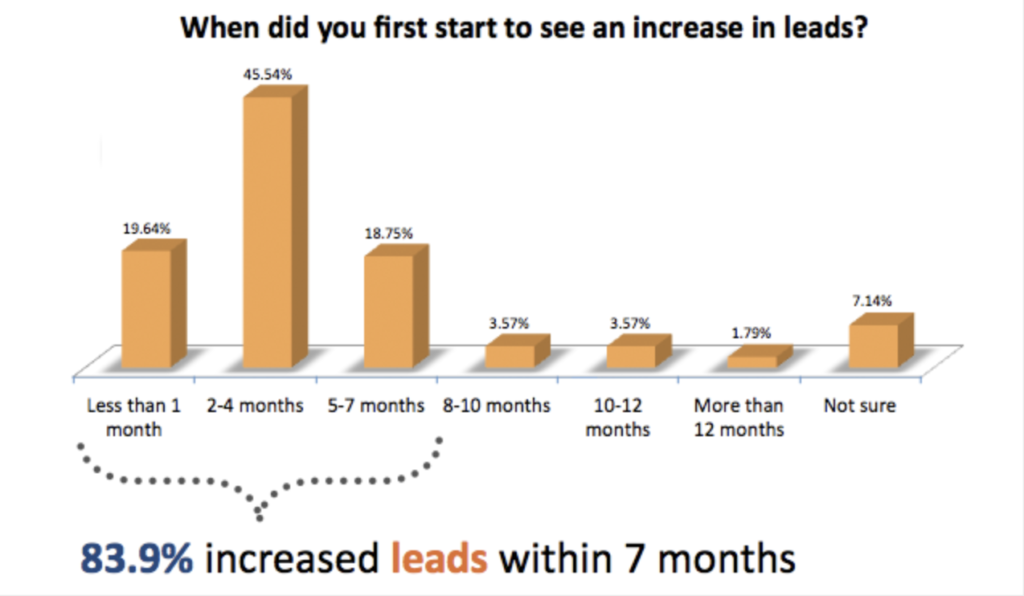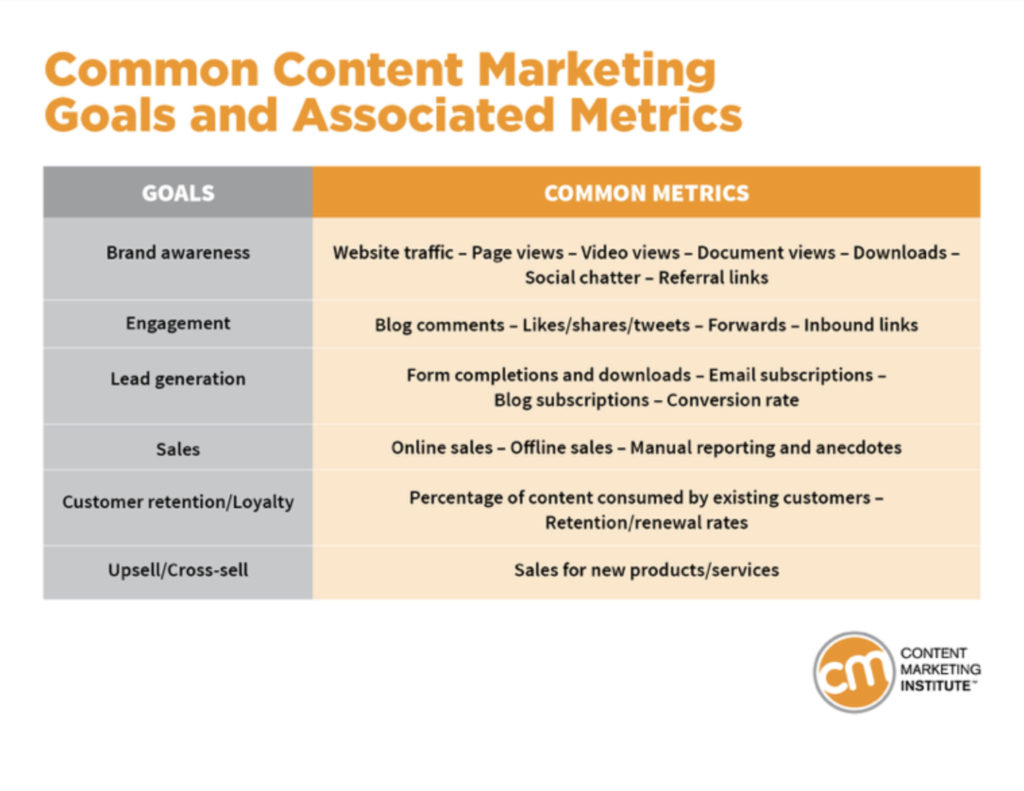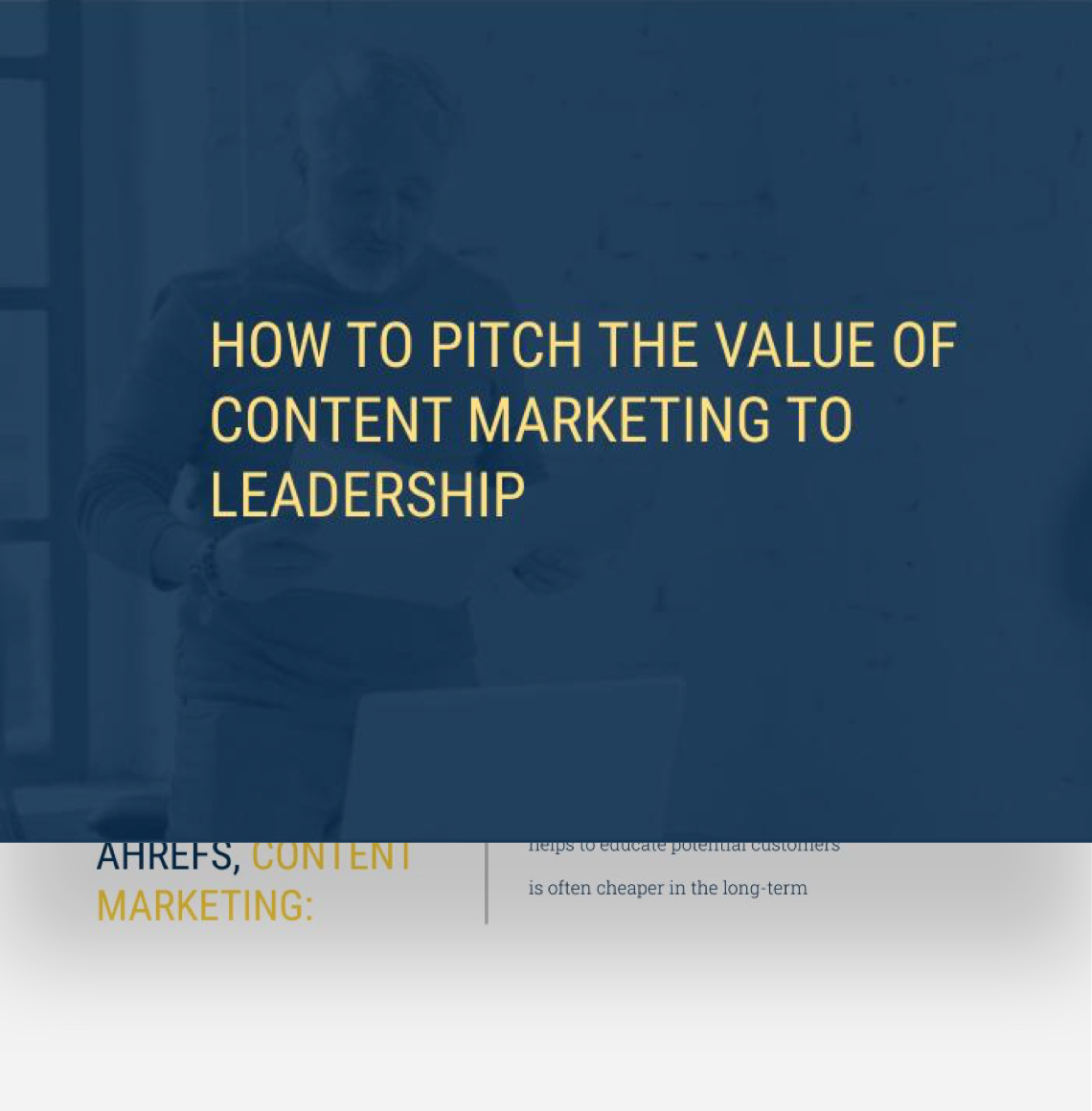Content Marketing ROI: Yes, You Really Can Measure It. Here’s How.
by April Williams
So, let me start with a confession. I have NOT always been a huge supporter of content marketing.
I know it’s scandalous, since I’m now the president of a company that sells content marketing.
But it’s the truth.
It all starts with the fact that, in some ways, I’m a typical business leader. I’m responsible for the day-to-day and P&L of SalesAmp. It’s my job to focus on the return on investment for the time and money my team is spending. It’s my job to be sure the time and money we spend is producing the desired results – and by results I mean revenue.
My hope is that explaining why I was not onboard and how I eventually came around to the idea (all without sacrificing my passion for results) will help you and your C-suite see the incredible results content marketing can bring to your business.
Why We’re Like This
I don’t think I’m alone in saying leading a business isn’t always easy. There’s a lot on the line for our clients and our team. And as owners, presidents, and c-suite dwellers we are not usually the most patient bunch when it comes to waiting for results.
Because measuring the ROI on content wasn’t straightforward, and content marketing wasn’t a fast play, I dismissed it.
The pace at which our industry—marketing & sales—changes is mind boggling. And in this world of instant gratification) content marketing is a long play.
Here’s why I didn’t value content marketing as a worthy investment for the business:
First: I didn’t fully understand what it was – because content marketing is different from traditional marketing.
Content marketing’s main focus is to create and distribute valuable, consistent, and relevant content that addresses your audience’s challenges. When done well, it attracts and retains your ideal target audience.
It is a big mindshift for marketing and sales.
That’s because content marketing’s goal is to provide useful content to help your prospects and clients solve their challenges – as opposed to pitching your products and services. It focuses on them, not you.
Second: I didn’t appreciate the fact that content marketing impacts the whole marketing funnel.
Because this is so different from what we in the c-suite are used to, change happened for me when those in marketing took the time to show the full breadth and depth of the reach of content.
Content can impact all stages of a business’ pipeline – and improve revenue growth, cost savings, brand loyalty, and operational efficiencies.
The Moment it Changed
I remember the moment when the light bulb began to light up for me.
One of our first SalesAmp clients was Philips Senior Living Division. After months of producing thought leadership content positioning their sales reps as subject matter experts (SME), one of the reps attended one of the largest conferences in their industry.
When she returned from the conference she told us that she was truly amazed at the amount of people that were seeking her out at this show, many mentioning the great content she’d been posting.
It was such a powerful moment for her, and for me hearing about it. She had been with the company for years and never had that happen until content marketing was a pillar tactic in our campaigns for them.
Once I had that, I was off to the races.
Content Marketing is Different – And Impacts the Entire Customer Journey
The amazing thing about content marketing is it impacts all three stages of the funnel. Con: It makes it harder to measure. But it continues to drive ROI after the sale is closed. Pro: This just means more revenue.
Top of the Funnel
At the top of the funnel it positions brands as the go-to thought leader in their industry. It also creates an impressive and cost-effective way to grow organic search traffic – helping people who are searching for what you do – actually find you.
Middle of the Funnel
In the middle of the funnel, content marketing is still hard at work boosting pipeline revenue by reaching those who want to continue to do their research online before reaching out to one of your sales reps.
Don’t take my word for it though:
- According to Lead Connect, 55% of companies take over five days to respond to demo requests. Product-led content allows you to show value upfront, and beat slower competitors.
- On average, consumers engage with 11(!) pieces of content before making a purchase decision.
Bottom of the Funnel
And at the bottom of the funnel – you guessed it – content marketing is still at work and actually doing some of its most impressive work by showing a direct correlation to increasing customer acquisitions.
Content marketing not only attracts more leads for your money, but it generates more quality leads too.
Our inside sales team at SalesAmp will vouch for this saying they would much rather follow-up with a lead that engaged with our content – it’s always a better conversation.
But What Kind of Timeframe are We Talking?
So while it may take longer to get the content marketing engine up and running, it will eventually yield a better ongoing ROI than traditional advertising.
If you’re like me, you might be asking yourself, okay if it’s worth the wait, just how long is the wait?
The answer? Not as long as you’d think.

Source: https://www.growthramp.io/articles/content-marketing-roi
Hubspot’s State of Inbound Marketing study found that increasing your publication cadence directly leads to greater customer acquisition. 82% of marketers who blog daily acquired a customer using their blog, as opposed to 57% who blog on a monthly basis.
(It’s worth pointing out here that only 7% of people said they weren’t sure.)
Content Marketing: The Gift that Keeps on Giving
But wait, there’s more!
Content marketing keeps generating revenue long after the sale has been closed, driving customer referrals and upsell opportunities.
And it helps to retain our current customers which is 6-7 times cheaper than obtaining new ones by staying in front of them and reminding them of all we can do for them, in addition to what they purchased from us and have long forgotten since the sale.
Call-out: By increasing its publishing cadence from 2 to 6 blogs a week, the content marketing agency NewsCred, saw 41% higher renewal rate, 33% more sales and 24% higher MRR (monthly recurring revenue) for customers who engage with their content.
Measuring Content Marketing ROI: An Uphill Climb Worth the View
Like I mentioned before, a big reason I wasn’t a huge fan of content marketing was the fact that I didn’t understand the metrics that I needed to see to understand the true impact of content marketing.
But, you can measure it. In fact, several people already have.
Content marketing typically generates three times as many leads as traditional marketing and costs as much as 62 percent less.
To ensure that your content marketing efforts are producing the ROI you desire you first need to identify your goals and how you plan to measure them. The Content Marketing Institute chart below is a very helpful tool as you start out on the ROI journey.

Be Better Than Your Competition! Impress Your Boss! Measure the ROI Successfully.
More than 90% of marketers use content marketing, but only 21% of B2B marketers and 23% of B2C marketers say they’re successful at tracking ROI (return on investment).
When talking about ROI it’s important to be sure that the right things are being measured.
Remember ROI is more of a business focus and thinking about what will impress us in the C-suite. (Hint: No one responsible for the P&L cares about views or clicks – they want to know what you are investing time and money in and if it’s generating revenue.)
Leadership’s goal is to grow the business at the lowest cost possible. But, the vast majority of marketing KPIs companies typically look at are simply indicators of performance, and not directly tied to revenues.
The biggest mistake I see marketers make today is to measure content marketing with KPIs that don’t matter to the c-suite, aka non-revenue KPIs – which means they will never get the approval for the budgets required for content marketing.
Want to get your budget approved? Get your goals aligned.
Most content marketers, unfortunately, don’t count revenue among their top three goals. Only 17% of content marketers in this survey from SEMRush consider increasing revenue a top priority.
Yikes.
This is where marketing teams need to sell the impact and value of content marketing to their C-suite. Marketers need to remember revenue is what drives your business. It’s what the C-suite execs want to see from their marketing campaigns.
The c-suite doesn’t care if you’re a “thought leader,” they care about increasing the bottom line. PERIOD. If you are reading this and saying “heck yeah! let’s do it!” – you are going to love what I have to say next.
Meet the Guy Who Wrote “How to Measure the ROI of Your Content, in 10 Steps.”
I spoke to Joe Lazauskas, when he was the CMO of Contently where we spoke about an article that he wrote, How to Measure the ROI of Your Content, in 10 Steps.
The article can help any marketer who is embarking on the Content Marketing ROI Journey – or any C-suite exec who wants to get a glimpse at what a really solid ROI plan for content marketing could look like.
Here at SalesAmp, I call it Joe’s Crawl, Walk, Run formula. Joe is very clear in advocating that content marketing is a solid tactic for driving revenue at your company.
But he’s also pragmatic: He’s clear that this takes effort and time to get the engine moving.
He speaks to three key steps: Crawl, Walk and Run. Sure, everyone wants to start out running, but those who succeed understand the importance of crawling, and then walking before you run. Here is a quick synopsis of Joe’s brilliance:
Crawl: Strategic to Audience Building
The crawl stage is all about measuring audience building. You need to attract an audience before you can measure the down-funnel actions people take.
- Audience Reach
- Audience Engagement
- SEO Effectiveness
Walk: Strategic to Lead Generation
Once you’ve started successfully building an audience, you want to inspire people to take actions that’ll create a deeper relationship with your brand—like signing up for a newsletter or virtual event, using an interactive tool, or requesting a demo.
- Leads Generated
- Lead Engagement
- Share of Voice
Run: Strategic to Revenue Generation
In the run stage, he covers the areas that’ll get your CMO and CFO excited—content attribution to revenue.
The model recommends three complementary approaches that will help capture the full picture of content’s impact on your bottom line.
- SEO Value
- Lead Value: A straightforward approach in which you multiply the number of leads your content generates by the traditional cost-per-lead (CPL) for your marketing team.
For instance, a leading B2B software company that Contently partners with recently launched a large-scale content campaign that drove 22,000 leads. Since the company’s average cost-per-lead was $71, the marketing team was able to attribute over $1.5 million in revenue impact to their content efforts, a 7x return on their investment.
Ex: 22,000 x $71 = $1.56M
Customer Serving, Revenue Growing. My Kind of Win, Win.
So there you have it – my journey from non-believer to completely sold on content marketing.
If you’re considering content marketing, I’d encourage you to take a moment to remember a few times where you googled a problem you were facing in your job, and found a really valuable solution in a piece of content marketing.
How did that make you feel? How did that make you feel about the company who published that content? And finally, did you end up working with that company in some way?
Content marketing is not an approach for the faint of heart; but we absolutely love it here at SalesAmp. Thinking you’re ready to take the plunge? I’m ready to chat, no judgment on how you’ve felt in the past about content marketing. Honest.
Pitch Deck: The Value of Content Marketing
Help leadership see the value of content marketing with this tool.
